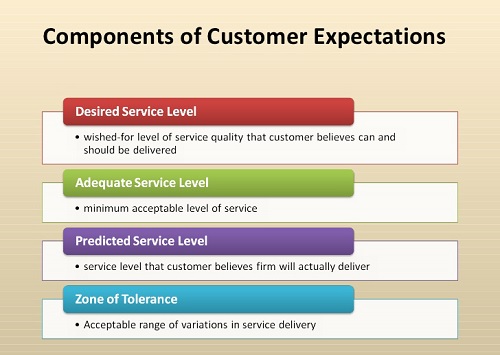
- Consumer Behavior - Home
- Consumer Behavior - Consumerism
- Consumer Behavior - Significance
- Demand Analysis
- Buying Decision Process
- Developing Marketing Concepts
- Marketing Strategies
- Market Segmentation
- Market Positioning
- Individual Determinants
- Consumer Behavior - Motivation
- Personality & Self Concept
- Attention & Perception
- Consumer Behavior - Learning
- Consumer Behavior - Attitude
- External Influence
- Influence of Culture & Social Class
- Relationship Marketing
- Reference Group
- Models of Consumer Behavior
- Consumer Behavior - Models Types
- Implications of Marketing Models
- Online Customer Behavior
- Consumer Behavior - Expectations
- Emerging Trends
- Emerging Issues
- Consumer Behavior - Cross Culture
- Consumer Behavior Resources
- Consumer Behavior - Quick Guide
- Consumer Behavior - Resources
- Consumer Behavior - Discussion
Consumer Behavior - Expectations
Before a company or a marketer can delight the customer, it must have an in-depth knowledge of the customers expectations so that not only are they able to meet but exceed the expectation, to delight the customer.
For this, knowledge of the core elements of the products and services are essential. The core elements of a product are its shape, quality, price, packaging, brand name differentiation etc. while the core elements of services are reliability, fulfillers and responsiveness to specific needs assurance and acceptability etc. from the service provided.
In the case of a product (tangible), the customer should be provided with what he expects and the core elements which remain almost the same. However, services being intangible and their characteristics which are intangible, inseparability, perishability etc. must be kept in mind.
The core elements given above can be manipulated to exceed the expectations of the customer as the human touch is also involved and this can give unexpected positive elements to delight the customer and have a competitive edge as well.
- A customer expects essential benefits.
- A customer expects performance and not blank promises.
- A customer expects competency.
Services and Products
A customer normally looks for the following services −
A customer wants consistency, which is the capacity to perform the promised services, reliably and accurately.
A customer wants tangibility or the form of physical facilities, equipment, workforce and other materials.
A customer wants reaction the reaction to an inquiry or to a call.
Working towards Enhancing Customer Satisfaction
To generate delight is not an easy job. Companies are varying with each other for competitive advantage.
A customer gets more satisfaction when he least expects it. In predicting the effects on product evaluation and customer satisfaction of disparity between expectations and actual or objective product performance; at least four psychological theories the company also delivers at the doorstep of the consumer which generates unparalleled value and satisfaction. For this, one must −
Attempt continuously to provide additional customer value in every transaction.
Try to provide surprise benefits.
Constantly express the expectations that the customer has around your product.
Treat the customer exclusively.
Look for expectations and performance gaps in order to identify opportunities to delight.
Customer Expectation and Satisfaction
Customer satisfaction may be defined as the products performance according to buyers expectations.
Consumers form expectations about the value of marketing offers and make buying decisions based on three expectations.
Customer satisfaction depends on the products actual performance relative to a buyers expectations. But, how do buyers form their expectations and expectations are based on the customers past buying experience.
Marketers must be careful to set the right level of expectations. If they set expectations too low they may satisfy those who buy, but fail to attract enough buyers.
Consumer satisfaction, a business term, is a measure of how products and services supplied by a company meet or surpass consumer expectation.
Take a look at the following illustration. It shows the major components of Customer Expectations −

Organizations are increasingly concerned in retaining existing customers while targeting non-customers. Measuring customer satisfaction provides an indication of how successful the organization is at providing products and/or services to the market place.